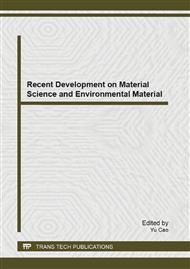[1]
F. James, M. Sepulveda, F. Charton, I. Quin̄ones, G. Guiochon l. Determination of binary competitive equilibrium isotherms from the individual chromatographic band profiles [J]. Chemical Engineering Science, 1999, 54(11): 1677-1696.
DOI: 10.1016/s0009-2509(98)00539-9
Google Scholar
[2]
N. Marchetti, A. Cavazzini, L. Pasti, F. Dondi, Determination of adsorption isotherms by means of HPLC: Adsorption mechanism elucidation and separation optimization [J]. Journal of Separation Science, 2009, 32(5-6): 727-741.
DOI: 10.1002/jssc.200800425
Google Scholar
[3]
A. Felinger, D. M. Zhou and G. Guiochon, Determination of the single component and competitive adsorption isotherms of the 1-indanol enantiomers by the inverse method [J]. Journal of Chromatography A, 2003, 1005(1-2): 35-49.
DOI: 10.1016/s0021-9673(03)00889-6
Google Scholar
[4]
M. Cheng, S. Li, F. Zhang, G. ZHANG, Determination of competitive adsorption isotherms of tryptophan enantiomers by inverse method [J]. Huagong Xuebao/Journal of Chemical Industry and Engineering (China), 2006, 57(5): 1177-1181.
Google Scholar
[5]
A. Velayudhan and C. Horvath, Adsorption and ion-exchange isotherms in preparative chromatography [J]. Journal of Chromatography A, 1994, 663(1): 1-10.
DOI: 10.1016/0021-9673(94)80490-7
Google Scholar
[6]
G. Guiochon, Preparative liquid chromatography [J]. Journal of Chromatography A, 2002, 965(1-2): 129-161.
DOI: 10.1016/s0021-9673(01)01471-6
Google Scholar
[7]
S. Y. Lee, K. M. Park, S. H. Jo, H.G. Nam,S. Mun, Determination of chromatographic separation parameters of tryptophan enantiomers on a Chirosil-SCA chiral stationary phase by using the inverse method based on the initial guesses estimated from elution by characteristic point method [J]. Journal of Chromatography A, 2010, 1218(8): 1195-1202.
DOI: 10.1016/j.chroma.2010.12.102
Google Scholar
[8]
Z. JIANG, J. KAN and Z. SONG, Ion exchange separation engineering [M]. TIANJIN: PRESS of University TIANJIN, (1992).
Google Scholar
[9]
C. V. McNeff, B. Yan, D. R. Stoll, R. A, Henry. Practice and theory of high temperature liquid chromatography [J]. Journal of Separation Science, 2007, 30(11): 1672-1685.
DOI: 10.1002/jssc.200600526
Google Scholar


